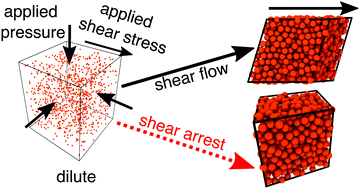Flow and arrest in stressed granular materials†
Abstract
Flowing granular materials often abruptly arrest if not driven by sufficient applied stresses. Such abrupt cessation of motion can be economically expensive in industrial materials handling and processing, and is significantly consequential in intermittent geophysical phenomena such as landslides and earthquakes. Using discrete element simulations, we calculate states of steady flow and arrest for granular materials under the conditions of constant applied pressure and shear stress, which are also most relevant in practice. Here the material can dilate or compact, and flow or arrest, in response to the applied stress. Our simulations highlight that under external stress, the intrinsic response of granular materials is characterized by uniquely-defined steady states of flow or arrest, which are highly sensitive to interparticle friction. While the flowing states can be equivalently characterized by volume fraction, coordination number or internal stress ratio, to characterize the states of shear arrest, one needs to also consider the structural anisotropy in the contact network. We highlight the role of dilation in the flow-arrest transition, and discuss our findings in the context of rheological transitions in granular materials.



 Please wait while we load your content...
Please wait while we load your content...